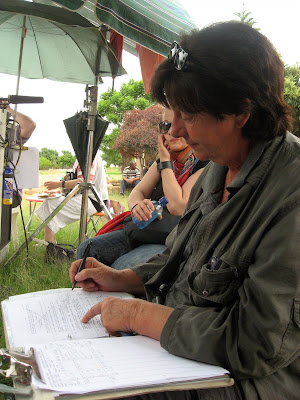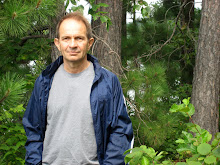
This is Oliver Stoltz, producer of the film version of Chanda's Secrets. Unfortunately, he had a serious stomach ailment during the first phase of the shoot when I was in South Africa, so this photo is taken from his website. (Oliver, you're way more attractive in person! Get a new photo!:))
I first met Oliver in 2005, when he was in Toronto promoting his Emmy-nominated documentary Lost Children, about child soldiers, at the documentary film festival Hot Docs. (It also won the German Oscar for Best documentary, and a host of other international awards.) I contacted Oliver as a research lead for my then-upcoming novel Chanda’s Wars. Oliver had first-hand experience with former child soldiers, having filmed in Uganda’s Gulu and Padr provinces, barely escaping attacks from the Lord’s Resistance Army. (He's WAY braver than me. Also a little crazy. 'Ask my mother,' he says.)
Despite his hectic schedule, Oliver took time to meet me twice and had me as his guest at the screening. I gave him a copy of Chanda’s Secrets and we said so long. A little later, I was in Germany doing a reading tour for my German publisher, Deutscher Taschenbuch Verlag, and Oliver and I reconnected in Berlin. He still had that rumpled just-rolled-out-of-bed look -- which I had first thought was because of all the press he was doing for Lost Children, but turns out to be just the way he looks.
(BTW: Here's the German cover of Chanda's Secrets. They titled it "Things We Don't Mention" in German. Apparently it's an expression used in Germany to refer to WWII; the publisher thought it would resonate with the German audience, and communicate the hush-hush nature of Chanda's struggle.)

Oliver told me how much he loved Chanda, and that he hoped to film the book in an international co-production with his German film company Dreamer Joint Venture Productions. On my next reading tour for dtv, this time for the German edition of Chanda's Wars (Chandas Krieg), Oliver introduced me to director Oliver Schmitz. Those of you follow this blog will know him already, but to newcomers, here's a shot of Oliver at work with Chanda and Mama:

And here, BTW, is the cover of the German edition of Chanda's Wars I was promoting:

Schmitz is an expatriate South African whose work has shown at Cannes and been well-received throughout Europe and Africa. (He was part of the directing collective with the Coen Brothers on Paris je t’aime.)
The commitment of both Olivers to my work, and their personal familiarity with the world and life of the novel, gave me utter confidence. I was also pleased that they took my suggestion of screenwriter -- the wonderful Dennis Foon. I gave them the contact info for the publisher, Annick Press, a deal was negotiated with Annick's film representative, and Oliver (Stoltz) went and got financing and a distributor. (He's co-producing with South Africa's Enigma Pictures; Bavarian International is the distributor.)
I have been treated so well. The Olivers and Dennis listened carefully to my notes on the adaptation -- something rare and to be treasured in the world of filmmaking. Maybe I'll chat about a few of the differences between book and film at a later date -- but all of the slight changes make sense in terms of film and completely adhere to the vision and story of the novel.
Next time, some candid shots around Elandsdoorn. Then home!
Cheers,
Allan
UPDATE: The film adaptation of CHANDA'S SECRETS is called LIFE, ABOVE ALL and will premiere as an Official Selection at the 2010 Cannes International Film Festival.























































